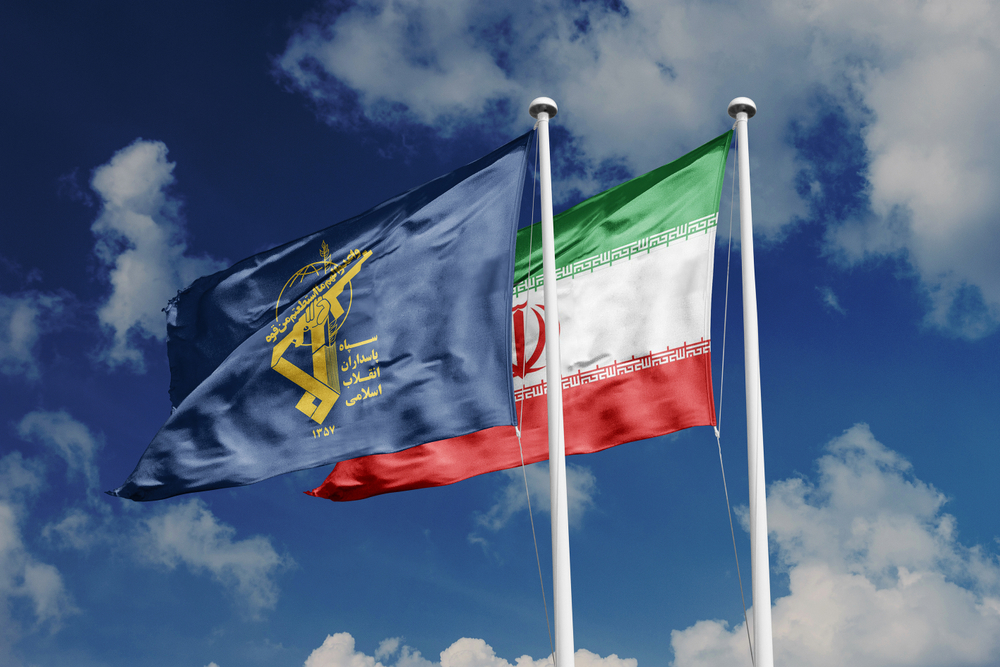UPDATES
Colonel Kemp’s views on Israel and Gaza echoed other senior military officers
March 27, 2015 | Allon Lee

The recent visit to Australia by retired British Colonel Richard Kemp, who was commander of British forces in Afghanistan, Yugoslavia, Northern Ireland and Iraq, generated national headlines (see for example here and here) when demonstrators disrupted his March 11 talk at Sydney University, as AIJAC’s Glen Falkenstein reported. The protesters tried to stop Col. Kemp from speaking, claiming he “supports genocide” for his assessment of last year’s war in Gaza (though he had not even mentioned either Israel or the Palestinians when the demonstrators attempted to shut down his talk).
However, once order was restored, Kemp did again assert his views on Israel’s tactics and conduct during that conflict:
“This protest was about my perspective on the IDF… I was in Israel during the 2014 summer conflict and I do believe that the IDF in their attack on Hamas in Gaza… were doing everything they could to protect civilians… People have told me I am wrong, but no one has told me what more steps Israel could take to minimise civilian casualties.”
Yet many people did not realise that Kemp is hardly alone among respected senior military figures willing to publicly voice their opinion that the Israeli Defence Forces’ tactics and conduct in last year’s war with Hamas were proportionate and reasonable – perhaps even exemplary, given the circumstances, despite the tragedy of the undoubted civilian casualties which did occur.
The essence of Kemp’s analysis of IDF conduct is evident in a written analysis he recently submitted to the UN Independent Commission of Inquiry on the 2014 Gaza Conflict – in which he also focuses on how other states are now seeking to learn from Israel’s tactics in fighting a non-state actor operating from an urban environment full of civilians:
In my opinion the actions taken by the IDF were necessary to defend the people of Israel from the ongoing, intensive and lethal attacks by Hamas and other groups in Gaza. It is the inalienable duty of every government to use its armed forces to protect its citizens and its terrain from external attack…
As the Gaza Strip is effectively a separate state, outside of Israeli control, these actions amounted to an attack by a foreign country against Israeli territory. In these circumstances I know of no other realistic and effective means of suppressing an aggressor’s missile fire than the methods used by the IDF, namely precision air and artillery strikes against the command and control structures, the fighters and the munitions of Hamas and the other groups in Gaza. Nor have I heard any other military expert from any country propose a viable alternative means of defence against such aggressions…
In conclusion, in my opinion the IDF took exceptional measures to adhere to the Laws of Armed Conflict and to minimise civilian casualties in Gaza. During the conflict many politicians, UN leaders, human rights groups and NGOs called on the Israelis to take greater action to minimise civilian casualties in Gaza. Yet none of them suggested any additional ways of doing this. I conclude that this was because Israel was taking all feasible steps. I believe Israel to be world leaders in actions to minimise civilian casualties; and this is borne out by the efforts made by the US Army, the most sophisticated and powerful in the world, to learn from the IDF on this issue.
Kemp’s message that Israeli actions on the battlefield were guided by the highest moral standards echoed those of US Chairman of Joint Chiefs of Staff Gen Martin Dempsey, who last November stated, “I actually do think that Israel went to extraordinary lengths to limit collateral damage and civilian casualties.”
Dempsey was so impressed that he ordered an American delegation to study Israel’s actions to prevent civilian casualties.
Now, an important new report by five retired US generals, (including Major General Mike Jones, Former Chief of Staff U.S. Central Command) has also determined that Israel’s efforts during last year’s war with Hamas to minimise civilian casualties were “virtually unprecedented”.
The report, commissioned by the Jewish Institute for National Security Affairs (JINSA) and titled “2014 Gaza War Assessment: The New Face of Conflict”, says that Israel’s efforts to avoid civilian casualties “adhered to or exceeded the Law of Armed Conflict (LOAC)…in a virtually unprecedented effort to avoid inflicting civilian casualties, even when doing so would have been lawfully permitted.”
Of Hamas, though it says, it “not only violated LOAC [laws of armed conflict] but also expertly enlisted and perverted its principals in an attempt to delegitimize Israel’s actions.”
Ahead of the forthcoming findings of the UN’s controversial inquiry into alleged war crimes perpetrated during the 50 days conflict, the study concludes that the reality of Israel’s efforts counts for little in international public opinion, because Hamas won the information war by successfully deploying lawfare to push the “false assumption that the law prohibits the infliction of any and all civilian casualties”, misrepresenting the concept of proportionality and convincing too many gullible people that Israel deliberately targetted civilians (which of course it didn’t).
Perversely, according to the report, Israeli restraint in fact actually “unintentionally empowered” Hamas in its campaign to “distort both the law and facts for its own purposes to the ultimate detriment of civilians’ safety, for which Hamas bears sole responsibility.”
It was able to do so, the study says, because “the expectations of some in the international community are not aligned with actual, applicable law governing armed conflicts”. Hamas successfully “exploited” a “general lack of understanding about the balance between military necessity and humanitarian protection central to LOAC to present a false narrative that combat operations which produce civilian casualties are inherently unlawful.”
The report levels four main accusations against Hamas:
• Acting with reckless disregard for civilian safety, if not deliberately putting them in harm’s way;
• Distorting internationally-recognized legal standards to exploit legal protections afforded civilians and the casualties caused by this exploitation;
• Portraying its opponent, through an information operations campaign, as legally culpable for what were lawful, defensive responses to aggression; and
• Securing advantageous pressure from the international community on its opponent to terminate legitimate defensive military action.
Hamas’ tactics should act as a warning for American political and military planners, the report’s authors write, and therefore be studied in anticipation they will be adopted and deployed by other groups seeking to undermine the legitimacy of America’s own military campaigns.
Critically, they noted that although the US has engaged in numerous urban battles, such as in Fallujah, Sadr City, Nasiriyah, Ramadi and elsewhere, “Hamas deployed a different and more dangerous concept of operations than the United States has encountered.”
This involved Hamas focusing on “the exploitation of the presence of civilians in the combat zone, not just as a passive defense tactic, but through actions intended to place its own civilians in jeopardy. Hamas’s strategy appears to have been to discredit Israel internationally by portraying the IDF’s military operations as indiscriminate and disproportional.”
On the flip side of the coin, Hamas’ own active military tactics show it “habitually violated LOAC” because “most of the rocket fires emanating from Gaza were not, as required by LOAC, directed at legitimate military targets, but rather at civilian population centres.”
(A point even Amnesty International has conceded in a new report that accuses Hamas of war crimes during the conflict. Unfortunately, as blogger Elder of Ziyon has noted, “even in this report, which admits that Hamas engaged in war crimes for firing rockets both at Israel and at its own citizens” Amnesty “proves its anti-Israel – and pro-Hamas – bias”!).
Moreover, Hamas’ rocket launchers “were situated in a way, such as at United Nations facilities, that violated LOAC obligation to refrain from placing vital military assets among civilian populations.”
As the report explains:
LOAC protects civilians by prohibiting deliberate attack against them, as well as attacks – even against lawful targets – when the attacking commander reasonably anticipates that the harm to civilians and damage to civilian property will be excessive in relation to the concrete and direct military advantage to be gained by the attack. But civilians are not entirely and always inviolable. They can forsake their legal protections by engaging in military activities and, while tragic, their incidental injury might be lawful if proper legal procedure is followed in targeting decision-making. LOAC does not render unlawful any attack that risks or even results in incidental injury and collateral damage; its principles are applied with a standard of the best available information at the time of a commander’s decision, not information that subsequently becomes available after an engagement.
Damningly, the report concluded that “Hamas’s infractions were deliberate, nor can we imagine a military justification for Hamas’s tactics” and, as the authors write:
Hamas’s embedding of military capabilities amid densely populated civilian areas in Gaza was not merely an incidental consequence of the operational environment or the fog of war, but instead a deliberate and unlawful tactic utilized to exploit the presence of civilians in an effort to obtain functional immunity from attack and degrade the IDF’s combat effectiveness.
By locating firing positions, weapons and ammunition and command and control facilities in populated areas, Hamas provoked IDF fire on locations that increased the probability of Gazan civilian casualties.
In contrast to Hamas, Israeli military efforts to minimise civilian casualties included:
maximizing the use of precision-guided munitions; selecting the lowest acceptable yield explosives; warning civilians with leaflets, text messages, telephone calls and radio transmissions to leave a defined area of operations or to seek shelter; assisting with the evacuation of civilians; firing smoke and illumination rounds prior to the use of explosive munitions in order to encourage civilian evacuation; and most notably, dropping a small, non-lethal explosive at an unoccupied corner of a structure to provide a “knock on the roof” warning of an impending strike. The IDF implemented unprecedented precautionary measures with full knowledge that they often would degrade the efficacy of an attack by allowing evacuation of military personnel, equipment or munitions.
Amazingly, the report recommended the US military not adopt Israeli tactics because they would set the bar too high:
raising standards in one instance – even if done as a matter of national policy and not as the result of legal obligation – risks creating a precedent to which military forces will likely be expected to adhere in the future. The result will not only be a greater danger to national security, but also an increased risk to civilians, since unconventional enemies will (like Hamas) deliberately seek to instigate civilian casualties in order to portray them, usually erroneously, as the result of unlawful attacks by their opponents.
Critically, away from the battlefront, the report suggested Hamas succeeded in propagating “misinformation and misconstrued legal arguments through media channels”. This it achieved through “restrictions on journalists’ movements within Gaza, effectively preventing them from providing coverage of Hamas’s indiscriminate firing against Israeli civilians and locating its military firing positions, weapons, ammunition and military facilities among Gazan civilians.”
The report is probably being too kind to the media. It was widely reported during the war, if not by the mainstream media, that journalists knew of or had witnessed Hamas and other groups firing rockets (see AIJAC’s blog posts here and here) from civilian areas, but refrained from reporting this, possibly to help preserve their access to Gaza. Hamas reportedly threatened some journalists who reported rocket fire.
Except in a handful of cases, most journalists appear to have deliberately self-censored or offered little detailed coverage of Hamas’ clear violations of LOAC.
This clearly was an institutional failure by the media to meet its responsibilities to report fairly and accurately on the conduct of all involved actors. In fact the Foreign Press Association did condemn Hamas’ threats to journalists but this was not until four weeks after the war had broken out. (Yet the Association’s condemnation was criticised by the New York Times‘ controversial Middle East correspondent Jodi Rudoren who Tweeted “Every reporter I’ve met who was in Gaza during war says this Israeli/now FPA narrative of Hamas harassment is nonsense.”)
Perhaps the report’s greatest value is in its insights as to why the Israel Defence Forces (IDF) failed to win the information war, despite its considerable efforts to meet legal standards. In the JINSA report’s view, this is principally because the IDF allowed Hamas to control the “narrative of the 2014 Gaza War.”
In our judgment, Israel encountered a series of institutional and external challenges that reduced the effectiveness of its information operations campaign.
First, there is a roles and capability mismatch. The IDF views the Ministry of Foreign Affairs (MFA) as responsible for international audiences. Yet, MFA officials we spoke with noted that they lacked the timely military information, video and images and the understanding of military operations and LOAC to effectively inform international reporting. Second, though full-motion video and other forms of intelligence that could counter Hamas’s claims of civilian casualties in Gaza often existed, the IDF was reluctant to release classified material to the media.
The report recommends the US “develop a whole-of-government approach that properly apportions responsibility, authority and resources to ensure that timely and highly accurate information about facts, law and policy is presented in a persuasive manner.”
A video and transcript of the generals at a media conference discussing their findings can be found here.
Meanwhile, an interesting counterpart to this report is a recent article in Tablet from James Kirchik, a fellow at the Foreign Policy Initiative, who offers an important perspective into Hamas’ enablers in the field of international human rights law who encourage the use of lawfare against Israel.
Kirchik recounts a recent dinner he attended with William Schabas, who was forced to resign as head of the Gaza inquiry courtesy of the clear conflict of interest he failed to declare in that he carried out paid legal work for the PLO in 2012.
In Kirchik’s opinion, Schabas and others like him who populate UN and NGO commissions and inquiries seem to believe “that the state’s power to wage war is fundamentally immoral. Violence perpetrated by the underdog-‘resistance’ by terrorist groups-falls under a different set of rules, however, a less stringent code of morality”. Kirchik sees Schabas as “a radical pacifist with his head in the sand” who seems unable to explain how countries like Israel can counter groups like Hezbollah which he readily acknowledges “‘have their own rule book'”.
Disturbingly, Schabas seemed to trust that “the Hezbollah fighter faced with a school filled with children is [not] going to say, ‘let’s go and kill them.’ “
According to Kirchik’s account, Schabas believes international law is shortly going to completely abolish all war, and interprets it in this light:
“I have a feeling that as human beings put on this planet that we’re at a period where we may not quite be there, but we’re getting close to abolishing war,” Schabas said, speaking of how much more violent the world was 100 years ago.
“We have the possibility to outlaw war completely,” he went on.
“You mean actually not have war?” I asked. “I think war is innate to humankind.”
“I disagree.”
“You really do? The last time we tried to outlaw war was the Kellogg-Briand Pact, and that didn’t go very well.”
“We outlawed it,” Schabas replied. “The Kellogg-Briand pact was the beginning. And then the Nuremberg trial. And the Charter of the United Nations. And it’s prevented global war.”
Attributing the failure thus far of World War III to launch to the niceties of the U.N.Charter and not, say, to the terrors of Mutually Assured Destruction, is the hallmark of a Model U.N. participant, not a serious scholar of global history. Neither the U.N. Charter nor the countless other treaties and legal instruments devised after World War II did anything to prevent the proliferation of incredibly bloody conflicts across the Third World (Korea, Vietnam, Angola,etc.) that functioned as Cold War proxy battles, nor the many small wars that have collectively claimed the lives of millions (Rwanda, Sudan, the Balkans, etc.) since the collapse of the Soviet Union. The Budapest Memorandum has not stopped Russia from waging war on Ukraine. U.N. Security Council Resolutions 1559, 1680 and 1701 have not led to Hezbollah’s disarmament. The Convention on the Rights of the Child has not stopped Burundi, Chad, the Democratic Republic of the Congo, Rwanda and a host of other nations-all signatories to the document-from exploiting children as soldiers.
For those who are interested, the IDF issued a primer last August highlighting Schabas’ more ridiculous utterances and positions revealing the mindset of those like him who would ennoble and enable groups such as Hamas as freedom fighters.
Also of interest is a story in Tower magazine that touches on the JINSA report and also quotes from other leading experts, including Israeli Amb. Alan Baker and UN Watch’s Hillel Neuer on how international law was perverted to suit Hamas’ agenda.
The contrast is obvious. Experienced military men like Kemp, Dempsey and Jones, who have experienced the realities of combat, view Israel’s efforts in Gaza in terms of reducing civilian casualties as not only acceptable, but even as an example to others.
Academics devoted to an idealised role for international law of making war entirely illegal – widespread in the UN and other international NGOs – are keen to jump on the bandwagon of claims from Hamas and its supporters that any civilian casualties are in themselves proof of war crimes – a standard never applied to any war in history.
The obvious question is why so many of those in neither camp are so keen to accept the ideologically driven views of the latter – who have never experienced combat – over the considered views of those who actually have.
Allon Lee
Tags: Anti-Zionism





